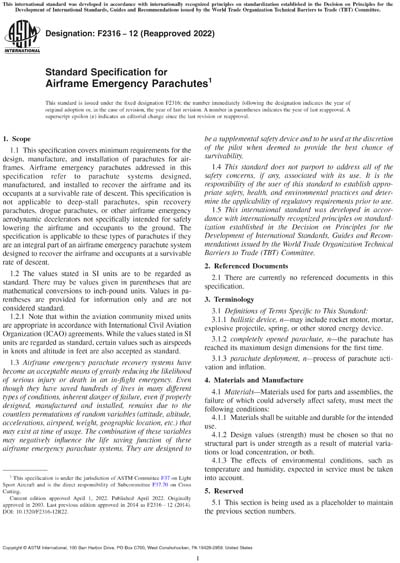Most recent
ASTM F2316-12(2022)
Standard Specification for Airframe Emergency Parachutes
1.1This specification covers minimum requirements for the design, manufacture, and installation of parachutes for airframes. Airframe emergency parachutes addressed in this specification refer to parachute systems designed, manufactured, and installed to recover the airframe and its occupants at a survivable rate of descent. This specification is not applicable to deep-stall parachutes, spin recovery parachutes, drogue parachutes, or other airframe emergency aerodynamic decelerators not specifically intended for safely lowering the airframe and occupants to the ground. The specification is applicable to these types of parachutes if they are an integral part of an airframe emergency parachute system designed to recover the airframe and occupants at a survivable rate of descent.
1.2The values stated in SI units are to be regarded as standard. There may be values given in parentheses that are mathematical conversions to inch-pound units. Values in parentheses are provided for information only and are not considered standard.
1.2.1Note that within the aviation community mixed units are appropriate in accordance with International Civil Aviation Organization (ICAO) agreements. While the values stated in SI units are regarded as standard, certain values such as airspeeds in knots and altitude in feet are also accepted as standard.
1.3Airframe emergency parachute recovery systems have become an acceptable means of greatly reducing the likelihood of serious injury or death in an in-flight emergency. Even though they have saved hundreds of lives in many different types of conditions, inherent danger of failure, even if properly designed, manufactured and installed, remains due to the countless permutations of random variables (attitude, altitude, accelerations, airspeed, weight, geographic location, etc.) that may exist at time of usage. The combination of these variables may negatively influence the life saving function of these airframe emergency parachute systems. They are designed to be a supplemental safety device and to be used at the discretion of the pilot when deemed to provide the best chance of survivability.
1.4This standard does not purport to address all of the safety concerns, if any, associated with its use. It is the responsibility of the user of this standard to establish appropriate safety, health, and environmental practices and determine the applicability of regulatory requirements prior to use.
1.5This international standard was developed in accordance with internationally recognized principles on standardization established in the Decision on Principles for the Development of International Standards, Guides and Recommendations issued by the World Trade Organization Technical Barriers to Trade (TBT) Committee.
Content Provider
ASTM International [astm]






